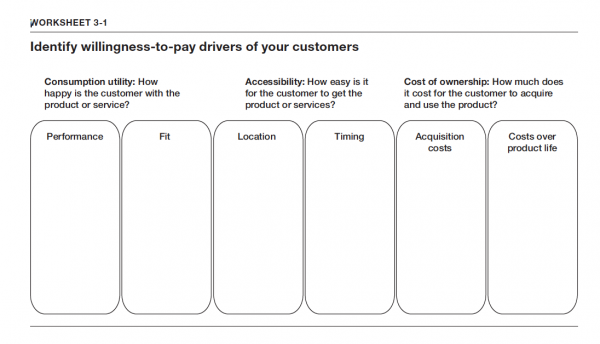The willingness-to-pay for a product or service is a result of three factors: how much a customer likes your product or service once he has it; how easy it is for him to obtain it; and how expensive it is to own the product. We will refer to the first part as consumption utility, the second part as accessibility, and the third part as the cost of ownership.
Consider consumption utility first. Consumption utility comes from various attributes of a product or service. For example, legroom (for air travel), the distance between two charges (for electric cars), weight (for bicycles), pixel count (for cameras), size (for clothing), and entertainment (for movies). The many possible attributes can be categorized into two groups:
Performance Attributes: Performance attributes are features of the product or service that most people agree are better. For example, we all prefer more legroom, longer distances before recharging, lighter bicycles, higher pixel resolution, and so on.
Fit Attributes: With some attributes, customers do not all agree on what is best. Some viewers like to watch House of Cards, while others might not. Some people enjoy a great steak, but vegetarians do not. When it comes to clothing, we have different body shapes and need differently sized clothes. Hence the term fit for these attributes.
Next, consider the accessibility of the product or service. Customers often face an inconvenience in obtaining the product or receiving the service. Economists often refer to this component as transaction costs or friction. Everything else being equal, we prefer our food here (as opposed to three miles away) and now (as opposed to after a thirty-minute wait).
The following are the two major components of accessibility:
Location: How far does your customer have to travel to get your product or service?
Timing: How long does your customer have to wait for your product or service?
The third and final component of willingness-to-pay is the cost of ownership.
As customers, we derive more value from a product that lasts longer and thus is cheaper on a per-usage basis. No matter whether it’s electronics, sports gear, furniture, or kitchen equipment, products wear out, become obsolete, or need to be replaced for other reasons. Other elements of the cost of ownership include the need for maintenance and repair, benefits from potential warranties, and everything else that customers need to pay for when using the product.
The worksheet below summarizes these dimensions of willingness-to-pay and will help you keep track of the relevant drivers in your business environment. The drivers of willingness-to-pay are the most important variables from the perspective of your customer. Some of them are obvious. We all want greater products or services right here, right now, and, ideally, free of charge.

Don’t stop there.
By having a connected relationship with your customer, including instantaneous communication, you can hopefully identify more subtle needs (and thus alternative drivers of willingness-to-pay) than “right here and right now.” For example, you might realize that your customer is afraid of planning for retirement because this would require difficult discussions with his spouse, or that your patient really felt sick multiple times before showing up to the emergency room but did not bring this up with the primary care physician during a regular visit because there wasn’t enough time.
Contributed to Branding Strategy Insider by: Nicolaj Siggelkow and Christian Terweisch. Excerpted from Connected Strategy: Building Continuous Customer Relationships For Competitive Advantage, (Harvard Business Review Press, May 21, 2019] Copyright 2019 by Harvard Business School Publishing Corporation. All rights reserved.
The Blake Project Can Help You Grow: The Brand Growth Strategy Workshop
Branding Strategy Insider is a service of The Blake Project: A strategic brand consultancy specializing in Brand Research, Brand Strategy, Brand Growth and Brand Education





One comment
Miguel L. Flores
July 22, 2019 at 9:32 pm
Mr. Siggelkow,
Great post! I believe it is crucial for brands to understand the factors that increase a customer’s willingness to pay. In particular, I think that performance and fit attributes play an important role for brands to identify the true needs and wants of their customers. After all, a potential customer will only be willing to pay of he/she wants or needs the products or services that the brand offers. This is a very helpful article for brands to better understand their customers.
Miguel L. Flores
Comments are closed.